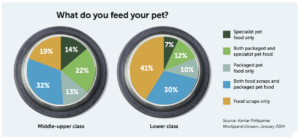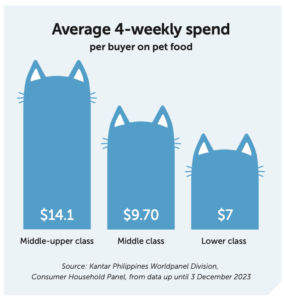Opportunities to shape the developing Filipino pet care market

There are plenty of openings for brands to be a part of the development of the sector in the Philippines. But to be successful, it’s important to understand the different types of potential consumers and the barriers to overcome.
It probably comes as no surprise that Filipinos are a pet- loving nation, with many households owning multiple pets. This presents early-moving brands with an opportunity to shape the market. However, companies intending to operate in the Philippines should bear in mind that how a pet is perceived and treated in terms of food and care often depends on the socio-economic class of its owner. Understanding the key factors affecting consumer preferences and buying behavior will increase a brand’s chance of success in this market.
Different roles among different classes
A survey conducted by the Worldpanel Division of Kantar Philippines in January found that 94% of Filipino households own a pet. Dogs are most common, owned by 68% of households, followed by cats (42% of households). In fact, the average number of pet types per Filipino household is 1.4, and these are often multiple types of animals – ranging from dogs and cats to birds, fish, chickens, goats, pigs and rabbits.
But the roles that pets play in people’s lives are not the same for everyone. The survey results show that higher socio-economic classes, who typically own a dog or cat, are most likely to view their pet as a family member or companion. As such, the pets tend to stay inside the house, and owners like to spend time cuddling, grooming and playing with them.
While dogs and cats are also the top 2 pet types owned by lower socio-economic classes, this group is more likely to own other types of pets such as chickens, goats and pigs. Only half of them keep their pet inside the house. Although 4 in 10 of these pet owners also view their pet as a family member, they are more likely to keep pets as a guard animal or as a hobby or sport.
Gaining a slice of the pet food pie
The abundance of pets in Filipino families, and the engagement of their owners, creates many opportunities for brands to play a role in the lives of pets and their owners. All pets need to eat, so the most obvious way is in the food space. Kantar’s survey found that 1 in 2 pet owners from higher socio-economic classes exclusively feed their pets packaged and/or specialist pet food. Furthermore, 1 in 3 feed their pets a combination of packaged pet food and food scraps, and 1 in 5 feed their pets with food scraps only. This means that even among this group, there is still plenty of room for brands to gain a share of what goes into pets’ stomachs.
That headroom becomes bigger (but perhaps more challenging to seize) among pet owners from lower socio-economic classes, 41% of whom exclusively feed their pets food scraps. Regardless, getting into those stomachs is lucrative. According to Kantar’s Household Panel, the most affluent pet owners spend PHP 791 ($14.14) on pet food in an average month.
Couple this with the expectation that, in this rapidly developing country, more Filipinos will climb up the socio-economic ladder and gain purchasing power in the coming years, and it becomes easy to picture a booming pet food market in the coming years.
Possibilities in pet care
The market potential does not stop there. Outside of pet food, there is a wide range of pet-related products and services for brands to consider entering. According to Kantar’s survey, more than 60% of pet owners from higher socio-economic classes, and almost half of pet owners from lower socio-economic classes, typically use pet care products such brushes, shampoo and paw balm.
In addition, almost 1 in 5 pet owners in higher socio-economic classes use hygiene or toilet products such as diapers or cat litter. Another 1 in 5 uses toys, and 1 in 10 typically uses a carrier or stroller to transport their pets. Add to that the many services that have opened in and around Metro Manila (the capital region and largest metropolitan area of the Philippines) – such as pet grooming salons and spas, dog daycares, pet hotels and pet taxis – and the future of a pet care brand becomes even brighter.
Focus on attracting buyers
Brands that jump in early have an opportunity to shape the market. Kantar’s advice for those who do so is to craft a strategy that focuses on attracting buyers. This requires a deep understanding of who its potential consumers are, including their pains and gains, their spending capacity, where and how they shop, and the potential barriers to overcome. Driving strong mental and physical availability, in the right channels, will be critical to reach them. Remembering that in-store shelf space is not unlimited, so carefully selecting a targeted assortment that is visible and stands out among other brands, is key.
Those who can demonstrate that their brand will drive incremental growth for not just their own business, but also the wider pet care category, will have the best chance of getting listed by retail partners. Now is the time to start shaping the future!


